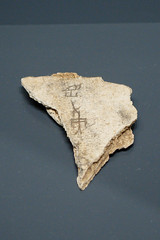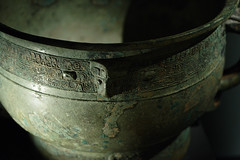Unification and Expansion: The First Chinese Empires
This chapter of the book covers the Qin Dynasty & the two halves of the Han Dynasty, who ruled China between 221BC and 220AD. The Qin Emperor was the first ruler to unite China under the rule of a central authority rather than the feudal states of previous dynasties. The Han emerged initially as the result of a peasant uprising against the second Qin Emperor, and subsequently ruled over China for about 400 years.
Orientation dates: We’re moving out of the time where I try to cross-reference with Egypt, and more into the Roman Empire. The last Egyptian date is the famous Cleopatra, who ruled 69BC to 30BC. For the Romans – the Second Punic War (Hannibal, elephants, etc) happened between 218BC & 202BC, roughly speaking matching the start of the earlier Han Dynasty. Julius Caesar was assassinated in 44BC. Britain (well, bits of) became part of the Roman Empire in 43AD. Hadrian ruled the Roman Empire from 117AD to 138AD, starting to build Hadrian’s Wall in 122AD. The Emperor Diocletian ruled from 284AD, so just outside the Han period.
The Qin Dynasty
Before the Qin Emperor was the Warring States period – China divided into 7 different kingdoms who fought amongst themselves, but still had a fair degree of continuity of culture. The Qin state was one of these kingdoms, and it had been a latish addition to the Zhou dynasty’s territory. Being on the edge of the country it had expansion prospects that central states didn’t, so ended up with a higher population and thus a bigger army than the other states. They’d also lucked out in having a series of rulers that were both long-lived and competent. So over the period of 256BC to 221BC they conquered the other six kingdoms. And the First Emperor ruled the whole of China for the next 11 years until his death.
The way the Qin empire was different from the previous unified states was that it was centralised and not feudal. The pre-existing kingdoms were dismantled and the land divided up into commandaries ruled by centrally appointed bureaucrats. Culture, laws, currency & weights were all standardised across the Empire – by dictat rather than by natural change. There was also a lot of forced labour, doing public works projects like roads & irrigation. And the first incarnation of the Great Wall of China was built during this period using conscript labour. The book had a whole section on the Great Wall which was interesting – I hadn’t realised that until modern times the Great Wall was a symbol of oppression and ultimate uselessness (because it didn’t actually keep the nomads out for long). I was aware (though only found out recently, via listening to an In Our Time programme) that the Great Wall that we can see today isn’t the original, the first incarnation would’ve been earth ramparts rather than stone walls.
The overall impression I got from the book was that lots of good and useful stuff happened during this decade, that would shape the future of united China. But it was achieved via a lot of oppression & cruelty, so it’s not a surprise that the First Emperor’s dynasty didn’t long outlast him. He died in 210BC, probably from taking mercury pills that were supposed to make him live forever (which is the sort of detail that feels like it should be in a fairytale as The Moral). His tomb was described in the ancient texts & is supposed to be spectacular & to include a scale model of the world complete with rivers of mercury. The only bit that’s been excavated is the Terracotta Army, the rest is waiting until the archaeologists are sure they won’t damage anything. But the tales of mercury rivers might well be accurate – apparently the soil in the region contains higher levels of mercury than other places nearby.
The First Emperor was succeeded by one of his sons – not the one he might’ve preferred, but the one that was there when he died. He sounds incompetent, and was persuaded to start off his reign by striking fear into the hearts of the people. Which didn’t work out all that well for him as they promptly rebelled!
The Former Han Dynasty
(I don’t much like this nomenclature for this bit of the Han Dynasty, but it’s what the book uses – except in the Chronology appendix which calls them the Western Han Dynasty like I’d seen other places. “Former Han” just sounds to me like this is people who once were Han but now are not, rather than the first half of the Han.)
The very beginning of the rebellion against the Second Emperor was a group of men who were on their way to the northern frontier for garrison duty, but were unavoidably delayed by poor weather making the roads impassable. Given that the punishment for being late was death one of them, Chen She started a rebellion instead of going quietly to his death. He died after only 6 months, but the rebellion gathered force, and eventually there were two men in charge of it, Xiang Yu (a former general) and Liu Bang (a peasant). They were successful in over-throwing the Qin dynasty and re-uniting China, but fell out over who would rule what. Liu Bang won in the end, and came to the throne as the first emperor of the Han Dynasty in 202BC.
The book talks a bit about the reign of Liu Bang (as Emperor Gaozu), and I think it turns into hagiography at this point. But it does explain that a lot of the actual apparatus of the state was the same as under the Qin Emperor, there’s even been law books found from both the early Han period and the Qin period, which have been compared and are much the same in terms of what there are laws about. The differences are more about tone – the Han did away with a lot of the crueller punishments, and forced labour. They also were more respectful of Confucian scholars, and in fact set up the education system for both bureaucrats and the general population along Confucian principles. Which would get them better press from later historians (who tended to be Confucian educated scholars …). They even went back to the system of bureaucrat run commandaries for dividing up the country – having originally given out kingships to allies during the revolution over time these were taken back again (as they got more rebellious against the Han). In general, if the Shang was the era that set up a lot of the traditional material culture of China, the Qin & early Han Dynasty was where the state apparatus and culture was formed.
It wasn’t all sunshine & roses, though – after the death of the first Han Emperor his wife ruled as regent for his son, and after her death her relatives rose up to seize power. This appears to’ve been aristocratic infighting rather than popular revolt (and resolved in favour of the Emperor’s descendants rather than his wife’s relatives). Wives for Emperors were often chosen from families with few male relatives to avoid this sort of thing, and from more humble families (after all it’s not like the Emperor had any peers, everyone was more lowly). The end of the Western Han came in 9AD when a regent (and relative of the late Empress) took the throne himself, establishing the Xin dynasty. And if it had stayed aristocratic infighting then this might’ve been the next Dynasty to rule China. However environmental disaster, caused by the Yellow River changing course, lead to thousands of refugees and chaos in the country. This popular uprising eventually lead to the downfall of the Emperor, and relatives of the earlier Han Dynasty took over again in 25AD forming the Later Han (or Eastern Han) Dynasty.
The Later Han Dynasty
The book is laid out partly in chronological order & partly in themes, and while there’s a place for both I’m not sure the balance is always right. I mention this here because there’s not actually much about the chronology of the 200 years of the later Han Dynasty. What there is is part of the section on the power of eunuchs, rather than separated out into its own section.
One of the themes they cover is the status & role of women in the Han dynasty period – which is interestingly sometimes more progressive than you might expect but in other ways is just as depressingly sexist as expected. It was during this period that the traditional role of women in China as inferior to men was articulated & laid down – they were supposed to be tranquil, submissive, do all the proper women’s work about the house without complaint, to subordinate all their interests to their husband (or father). This was the Confucian ideal of womanhood, and it fits with the general hierarchical nature of Confucian ordering of the world. But high-born women were also frequently well educated – perhaps it was just to enable them to better help their husbands, but even so they got the education. And in the Emperor’s harem in particular they had status & influence on the issues of the state. Particularly during the later Han Dynasty when the Emperors spent more time in the harem where there were no men, only eunuchs & women. And there was equal pay for equally ranked women & men – the concubines apparently got ranked on the same scale as the male officials, with the most senior ones being at the same rank as the most senior men and receiving the same pay.
Another of the themes is technology and medicine. There were several advances in both agricultural & military technology over the period, primarily driven by better iron working technology and the abundance of iron ore in China. But in terms of military advances they also had good map making abilities, and some of the maps from the early Han Dynasty correspond well to modern maps. Which is pretty impressive if you think about the things that medieval European mapmakers drew and called “accurate” 😉 The biggest thing to happen during this period from a technological point of view was the development of better paper. Paper had possibly been made before (and used by lower class people because silk would be too expensive for them), but in 105AD one of the eunuchs in the service of the later Han Dynasty is credited with making high quality paper, fit for the court and bureaucracy to use.
The later Han Dynasty Emperors would spend most of their time in the harem, and so eunuchs gained more power because of their greater access to the Emperor. But being castrated was a disgrace, and so they weren’t held in high regard by the other officials & aristocrats. Which clearly leads to infighting and political manoeuvring between the eunuchs and the rest of the court. Towards the end of the Han Dynasty this got pretty nasty, with mass demonstrations or riots & murder. Eventually it led to the dis-unification of China & the start of the next period of Chinese history (and the end of this chapter!).
Tangents to follow up on: Mostly I’d like to know a bit more about the Qin and the very beginning of the Han Dynasty, some of the stuff in this book felt a little bit too much like repeating the stories that the traditional histories tell.



